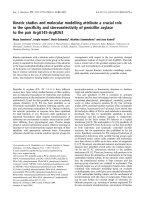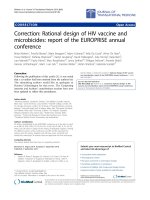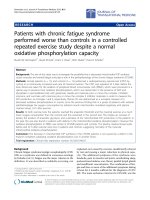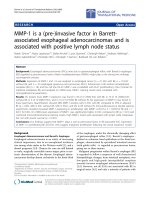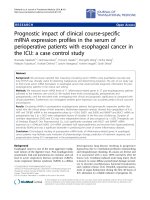Báo cáo hóa học: " Homologous recombination is unlikely to play a major role in influenza B virus evolution" doc
Bạn đang xem bản rút gọn của tài liệu. Xem và tải ngay bản đầy đủ của tài liệu tại đây (205.17 KB, 3 trang )
BioMed Central
Page 1 of 3
(page number not for citation purposes)
Virology Journal
Open Access
Short report
Homologous recombination is unlikely to play a major role in
influenza B virus evolution
Guan-Zhu Han*
†1,2
, Xi-Ping Liu
†2
and Si-Shen Li*
1
Address:
1
National Key Laboratory of Crop Biology, College of Agronomy, Shandong Agricultural University, Tai'an 271018, China and
2
College
of Life Science, Shandong Normal University, Jinan 250014, China
Email: Guan-Zhu Han* - ; Xi-Ping Liu - ; Si-Shen Li* -
* Corresponding authors †Equal contributors
Abstract
Influenza B viruses cause a significant amount of morbidity and mortality. The occurrence of
homologous recombination in influenza viruses is controversial. To determine the extent of
homologous recombination in influenza B viruses, recombination analyses of 2,650 sequences
representing all eight segments of the influenza B viruses were carried out. Only four sequences
were indentified as putative recombinants, which were verified using phylogenetic methods.
However, the mosaics detected here were much likely to represent cases of laboratory-generated
artificial recombinants. As in other myxoviruses, it is unlikely that homologous recombination plays
a major role in influenza B virus evolution.
Background
Influenza B viruses cause substantial morbidity and mor-
tality in humans. As a member of the Orthomyxoviridae
family, influenza B virus possesses a single-stranded and
segmented genome of negative sense. Unlike influenza A
viruses, no antigenic shift has ever been detected in influ-
enza B viruses. No subtype divisions of surface antigens
exist and two lineages, Victoria lineage and Yamagata lin-
eage, have diverged since 1983 as defined by the phyloge-
netic relationship of the hemagglutinin (HA) gene [1]. All
11 genes of influenza B viruses have diverged into two
new lineages prior to 1987 [2,3]. Reassortment occurs fre-
quently among influenza B viruses and likely allows unre-
stricted lineage mixing [2].
To date, there is also ample evidence that various forms of
non-homologous recombination, albeit rarely, occurs in
influenza viruses [4-6]. However, the occurrence of
homologous recombination in influenza viruses is con-
troversial and far from proven. For influenza A viruses,
Gibbs et al. proposed that homologous recombination
had occurred in the HA gene of 1918 Spanish flu virus [7].
However, the apparent recombination event described by
Gibbs et al. is much likely to result from a difference in the
substitution rate of evolution between HA1 and HA2 [8].
More recently, Boni et al. demonstrate that homologous
recombination is very rare or absent in human influenza
A viruses through analyzing a data set of 13,852 sequences
representing all eight RNA segments and of both major
circulating subtypes, H3N2 and H1N1 [9]. Therefore,
whether homologous RNA recombination occurs in influ-
enza viruses is one of the key research questions in influ-
enza virus evolution [10].
Results and Discussion
To access whether homologous RNA recombination plays
a role in the evolution of influenza B viruses, we compiled
a data set of 2,650 sequences (PB2, 224; PB1, 230; PA,
230; HA, 330; NP, 236; NA, 687; MP, 332; NS, 381) rep-
resenting all eight RNA segments. The sequences were
Published: 27 May 2008
Virology Journal 2008, 5:65 doi:10.1186/1743-422X-5-65
Received: 10 April 2008
Accepted: 27 May 2008
This article is available from: />© 2008 Han et al; licensee BioMed Central Ltd.
This is an Open Access article distributed under the terms of the Creative Commons Attribution License ( />),
which permits unrestricted use, distribution, and reproduction in any medium, provided the original work is properly cited.
Virology Journal 2008, 5:65 />Page 2 of 3
(page number not for citation purposes)
obtained from the Influenza Virus Resource [11] and then
aligned using Clustal X [12]. To gain an initial insight into
possible recombination events, each of the eight data sets
was analyzed respectively using the 3SEQ [13], the Chi-
maera [14], and the RDP [15] methods, which are availa-
ble in RDP (Recombination detection program) software.
Interestingly, all these three methods implemented got
the same results. Only four potential recombinants were
primarily identified (Table 1). The recombinants were dis-
tributed over only three (PB2, NA, and HA) of the eight
influenza B virus RNA segments.
Recombination events were further confirmed and the
exact breakpoints were identified using GARD (Genetic
Algorithm Recombination Detection) online [16,17]. To
better evaluate the evidence for these recombination
events, the breakpoints identified by GARD were used to
divide the alignment into two parts to construct phyloge-
netic trees respectively. Phylogenetic trees were generated
using the Maximum Composite Likelihood (MCL)
method for estimating evolutionary distances and neigh-
bor-joining (NJ) method [18] in MEGA4.0 [19]. The phy-
logenetic trees were tested with bootstrap of 1000
replicates. The occurrence of incongruent phylogenetic
trees, the most compelling evolutionary evidence for
recombination, was observed for all the four putative
recombinants which further confirmed the results of the
recombination analyses above. Meanwhile, topological
shifts for each of the recombinants have strong bootstrap
support (data not shown).
However, large influenza viral genes in the databases may
actually represent assembled artifactual contigs from dif-
ferent but homologous gene segments present in a mixed
sample to begin with. Such artifactual contigs are also
likely to be produced in a mixed sample by template
switching during PCR amplification [20] even if only a
single primer set is used. Mixture of viruses was present
leading to the illusion of a recombination event as a con-
sequence of the sequencing methodology being
employed. A plausible explanation for the "recom-
binants" detected here is contamination by influenza
virus derived PCR products, which could combine during
PCR amplification to generate apparent, but artifactual
recombinants. None of the three putative recombinant
viruses were derived by plaque purification. Furthermore,
the same laboratory was the source for all four recom-
binants and the one putative parental strain. As suggested
in influenza A virus [9], further work would be needed to
conclusively demonstrate homologous recombination in
influenza B viruses. Recombinant influenza virus must
either be plaque purified or multiple clones must be iso-
lated and sequenced from the same individual or animal
host. The presence of both the recombinant and parental
genotypes should be found in the sample [21]. Alterna-
tively, homologous recombination could be demon-
strated by showing that recombinant sequences form a
distinct lineage circulated among multiple identified indi-
viduals [22].
Conclusion
To sum up, our analysis showed that homologous recom-
bination in influenza B viruses was very rare or absent and
could not confer a substantial fitness advantage. There-
fore, we conclude that homologous recombination is
unlikely to play a major role in influenza B virus evolu-
tion.
Competing interests
The authors declare that they have no competing interests.
Authors' contributions
GZH, SSL designed the study; GZH, XPL carried out the
study; GZH, SSL, XPL drafted the manuscript. All authors
read and approved the final manuscript.
Acknowledgements
We thank Dr Maciej Boni for many highly constructive discussions. We also
thank Drs Jon McCullers and Takehiko Saito for providing important infor-
mation on the strains B/Memphis/5/93 and B/Norway/1/84 respectively.
References
1. Hay AJ, Gregory V, Douglas AR, Lin YP: The evolution of human
influenza viruses. Phil Trans R Soc Lond B Biol Sci 2001,
356:1861-1870.
Table 1: Influenza B virus strains with significant recombination signal
Segment Recombinant Accession No. Putative Parents 3SEQ p-value Breakpoint Δ c-AIC
PB2 B/Memphis/5/93 AY582061 B/Shiga/T30/98 4.496 × 10
-21
1665 105.592
B/Alaska/03/1992
PB2 B/Norway/1/84 AF101984 B/Guangdong/05/94 6.654 × 10
-13
1206 78.8114
B/Chile/3162/2002
HA B/Memphis/5/93 AF129902 B/Houston/B56/1997 8.988 × 10
-11
885 56.3597
B/Houston/1/92
NA B/Memphis/3/93 AF129915 B/Alaska/03/1992 1.665 × 10
-14
808 70.3841
B/Memphis/10/97
Publish with BioMed Central and every
scientist can read your work free of charge
"BioMed Central will be the most significant development for
disseminating the results of biomedical research in our lifetime."
Sir Paul Nurse, Cancer Research UK
Your research papers will be:
available free of charge to the entire biomedical community
peer reviewed and published immediately upon acceptance
cited in PubMed and archived on PubMed Central
yours — you keep the copyright
Submit your manuscript here:
/>BioMedcentral
Virology Journal 2008, 5:65 />Page 3 of 3
(page number not for citation purposes)
2. McCullers JA, Saito T, Iverson AR: Multiple genotypes of influ-
enza B virus circulated between 1979 and 2003. J Virol 2004,
78:12817-28.
3. Hiromoto Y, Saito T, Lindstrom SE, Li Y, Nerome R, Sugita S, Shinjoh
M, Nerome K: Phylogenetic analysis of the three polymerase
genes (PB1, PB2 and PA) of influenza B virus. J Gen Virol 2000,
81:929-937.
4. Khatchikian D, Orlich M, Rott R: Increased viral pathogenicity
after insertion of a 28S ribosomal RNA sequence into the
haemagglutinin gene of an influenza virus. Nature 1989,
340:1567.
5. Orlich M, Gottwals H, Rott R: Nonhomologous recombination
between the hemagglutinin gene and the nucleoprotein
gene of an influenza virus. Virology 1994, 204:462-465.
6. Suarez DL, Senne DA, Banks J, Brown IH, Essen SC, Lee CW, Manvell
RJ, Mathieu-Benson C, Moreno V, Pedersen JC, Panigrahy B, Rojas H,
Spackman E, Alexander DJ: Recombination resulting in viru-
lence shift in avian influenza outbreak, Chile. Emerg Infect Dis
2004, 10:693-699.
7. Gibbs MJ, Armstrong JS, Gibbs AJ: Recombination in the hemag-
glutinin gene of the 1918 "Spanish flu". Science 2001,
293:1842-1845.
8. Worobey M, Rambaut A, Pybus OG, Robertson DL: Questioning
the evidence for genetic recombination in the 1918 "Spanish
flu" virus. Science 2002, 296:211.
9. Boni MF, Zhou Y, Taubenberger JK, Holmes EC: Homologous
Recombination is Very Rare or Absent in Human Influenza
A Virus. J Virol 2008, 82:4807-4811.
10. Nelson MI, Holmes EC: The evolution of epidemic influenza.
Nat Rev Genet 2007, 8:196-205.
11. The Influenza Virus Resource [ />genomes/FLU/Database/select.cgi]
12. Thompson JD, Gibson TJ, Plewniak F, Jeanmougin F, Higgins DG: The
CLUSTAL X windows interface: flexible strategies for multi-
ple sequence alignment aided by quality analysis tools. Nucl
Acids Res 1997, 25:4876-4882.
13. Boni MF, Posada D, Feldman MW: An exact nonparametric
method for inferring mosaic structure in sequence triplets.
Genetics 2007, 176:1035-1047.
14. Posada D, Crandall KA: Evaluation of methods for detecting
recombination from DNA sequences: Computer simula-
tions. Proc Natl Acad Sci 2001, 98:13757-13762.
15. Martin DP, Williamson C, Posada D: RDP2: recombination detec-
tion and analysis from sequence alignments. Bioinformatics
2005, 21:260-262.
16. GARD (Genetic Algorithm Recombination Detection)
[ />]
17. Kosakovsky Pond SL, Posada D, Gravenor MB, Woelk CH, Frost SD:
Automated phylogenetic detection of recombination using a
genetic algorithm. Mol Biol Evol 2006, 23:1891-1901.
18. Saitou N, Nei M: The neighbor-joining method: a new method
for reconstructing phylogenetic trees. Mol Biol Evol 1987,
4:406-425.
19. Tamura K, Dudley J, Nei M, Kumar S: MEGA4 Molecular Evolu-
tionary Genetics Analysis (MEGA) Software Version 4.0. Mol
Biol Evol 2007, 24:1596-1599.
20. Odelberg SJ, Weiss RB, Hata A, White R: Template-switching
during DNA synthesis by Thermus aquaticus DNA polymer-
ase I. Nucl Acids Res 1995, 23:2049-2057.
21. Aaskov J, Buzacott K, Field E, Lowry K, Berlioz-Arthaud A, Holmes
EC: Multiple recombinant dengue type 1 viruses in an isolate
from a dengue patient. J Gen Virol 2007, 88:3334-3340.
22. Wittmann TJ, Biek R, Hassanin A, Rouquet P, Reed P, Yaba P, Pourrut
X, Real LA, Gonzalez JP, Leroy EM: Isolates of Zaire ebolavirus
from wild apes reveal genetic lineage of recombinants. Proc
Natl Acad Sci USA 2007, 104:17123-17127.
